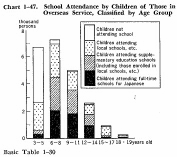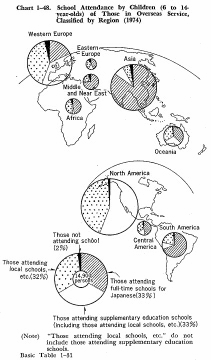| Home > Policy > White Paper, Notice, Announcement > White Paper > EDUCATIONAL STANDARDS IN JAPAN 1975 > CHAPTER1 6 | ||
Paralleling the promotion of political, economic and cultural exchange with foreign countries, the number of those people assigned to overseas posts by enterprises and government agencies has been on a remarkable increase. Accordingly, the number of children accompanying their parents assigned to overseas posts has also been growing. Therefore, the demand has grown to secure the opportunity of education for those children and to improve the system of providing them with the appropriate education after their return to Japan.
As of 1974, the number of 3 to 19-year-old children residing overseas was estimated at 22,800 persons, of whom 65% or 14,900 (estimated 8,700 in 1971) were in the 6-14 age group or at the compulsory education age. Classified by the age group, the proportion of 6 to 8-year-old children was the largest at 32%, followed by that of 3 to 5-year-old children at 30% and 9 to 11-year-old children at 22%. Their type of school attendance is roughly divided into three categories, namely, "attending full-time schools for Japanese," "attending supplementary education schools" (most of them are simultaneously attending either of local schools, local schools for foreigners, local schools for children of Japanese descent or home schools) and "attending either local schools, local schools for foreigners, local schools for children of Japanese descent or home schools, "with one-third of these children falling under each of these three categories. In addition, the proportion of "those not attending school" of 6 to 14-year-old children at the compulsory education age, is limited to l.8%. The proportion of 3 to 4-year-old children who do not attend schools and that of 15 to 19-year-old children attending either of "local schools, local schools for foreigners, local schools for children of Japanese descent or home schools" turn out high at 60% and 79% respectively. This is because full-time schools for Japanese and supplementary education schools are designed to give education chiefly to 6 to 14-year-old children at the compulsory education age.

Regional distribution of 6 to 14-year-old children residing overseas and their types of school attendance are shown in Chart 1-48. The proportion of residence is highest in North America (39%), Asia (23%) and Western Europe (20%), with 82% of all children involved residing in these regions. The proportion of those attending full-time schools for Japanese is highest in Asia (85%), Middle East (74%), South America (69%), etc., while that of children attending supplementary education schools is highest in North America (56%), Western Europe (38%), etc. And the proportion of children attending local schools, local schools or foreigners, local schools for children of Japanese descent or home schools is highest in Africa (44%), North America (44%), Western Europe (41%), etc.
In addition, as of 1974, there were total 33 full-time schools for Japanese (including 16 in Asia) and a total of 49 supplementary education schools (including 16 in Western Europe and 15 in North America).

| Back to Top | MEXT HOME |